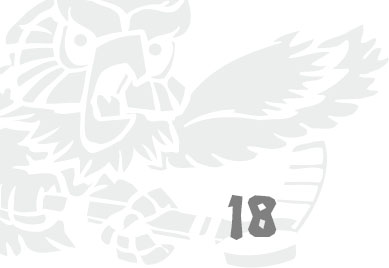
Where did Joe Hall go?” asked Travis.
Sarah looked around. “I hope he’s gone to see a doctor.”
Travis had no time to go look for him. There were photographers and reporters and more cheers and a Little Stanley Cup ring to try on. Soon an hour or more had passed, and they still hadn’t seen Joe Hall.
Finally, with the cheering over and the ice already being cleaned, the triumphant Owls made their way back to the dressing room. Mr. Dillinger was there, packing up the equipment for the long bus ride home.
But still no Joe Hall.
Travis undressed, showered, and changed. He was just doing up his shirt when Data wheeled up and handed him a folded piece of paper. “You might want to look at this, Travis.”
It was, as Travis expected, the results of Data’s computer search for Joe Hall. Sure enough, it turned out there were hundreds of Joe Halls, even several Joe Halls in hockey. But only one “Bad” Joe Hall.
Travis read frantically.
Hall, Joe: “Bad” Joe Hall was born in England but was raised in Canada. He played professional hockey at the beginning of the 20th Century, mostly for the Montreal Canadiens. He was famous for his bad temper–he was once taken o? the ice in a police paddy wagon!–but later came to regret the playing time his temper had cost him. Hall’s Canadiens met the Seattle Metropolitans to decide the 1919 Stanley Cup, but the Spanish flu struck the Montreal team badly. Five players were too sick to play, and when Joe Hall died, the championship was cancelled that year–the only time in history there has been no Stanley Cup awarded.
Travis read it twice. He could make no sense of it. It was impossible.
Sarah popped her head into the dressing room.
Travis looked up, hopeful. “Did you find him?”
Sarah shook her head, then she stopped and smiled. “I don’t know–maybe I did.”
Travis was more puzzled than ever. Either she had found Joe Hall or she hadn’t.
“Come on out here a minute,” Sarah said.
She took him up the back stairs to the front foyer of the Corel Centre, where the original Stanley Cup was back on display and the fans were lining up by the hundreds to have their pictures taken with it and the other trophies from the Hockey Hall of Fame.
But it wasn’t the trophies that Sarah wanted to show him. “Over here,” she said. “The display cases.”
They moved over to several large glass cases containing memorabilia from the Silver Seven and the early Ottawa Senators. There were even photographs of the Rideau Rebels, and a great picture of “One-Eyed” Frank McGee and Harry “Rat” Westwick.
But she wanted to show him something else. “Look in this case,” Sarah said.
Travis peered in. Old skates, equipment, sweaters, a hockey stick. He saw nothing to tell him where Joe Hall had gone.
“What?” he said.
“Recognize the stick?” she asked.
Travis looked again. It was in the far corner of the case. An old, perfectly straight hockey stick.
And at the top, near the handle, was pencilled a single name.
“J. Hall.”
THE END